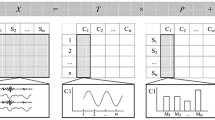Abstract
Factor analysis of the motor profile parameters demonstrated that the so-called instrumental tests became a separate factor only in athletes, and the features of carrying out these tests correlated with the wrestlers' stances. Apart from this, different indices of the athletes' hand preference were divided into many factors. The data of dichotic and dichoptic tests showed that, firstly, the athletes demonstrated a preponderance of the right hemisphere in processing verbal and visual–spatial information; secondly, the wrestlers' athletic results correlated with the preponderance of the left hemisphere in speech perception. The controversial character of the data obtained is explained by the bilateral organization of motor control in wrestlers and the involvement of the regulatory mechanisms of the interhemispheric interaction.
Similar content being viewed by others
REFERENCES
Khomskaya, E.D.,Efimova, I.V.,Budyka, E.V., andEnikolopova, E.V., Neiropsikhologiya individual'nykh razlichii: uchebnoe posobie (Neuropsychology of Individual Differences: A Textbook), Moscow: RPA, 1997.
Egorov, V.A. andShirogorov, V.K., Motor Asymmetry and Changes in It in Pilots under the Influence of Flights, Vopr. Psikhol., 1976, no. 3, p. 129.
Leutin, V.P. andNikolaeva, E.I., Psikhofiziologicheskie mekhanizmy adaptatsii i funktsional'naya asimmetriya mozga (Psychophysiological Mechanisms of Adaptation and Cerebral Functional Asymmetry), Novosibirsk: Nauka, 1988.
Matova, M.A., Formation of Asymmetry and Symmetry of the Visual Perception in the Course of Human Practical Activity, Vopr. Psikhol., 1980, no. 1, p. 64.
Ermakov, P.N., Asymmetry of Motor Reactions of the Upper and Lower Extremities in Humans, Fiziol. Chel., 1986, vol. 12, no. 3, p. 507.
Day, L.B. andMacNeilage, P.F., Postural Asymmetries and Language Lateralization in Humans ( Homo sapiens ), J. Comp. Psychol., 1996, vol. 110, p. 88.
Tan, U., A Close Relationship Exists between Hand Skill and the Excitability of Motor Neurons Innervating the Postural Soleus Muscle in Right-Handed Male Subjects, Int. J. Neurosci., 1990, vol. 53, p. 63.
Liedermann, J. andCorvell, J., Right-Hand Preference Facilitated by the Rightward Turning Biases during Infancy, Dev. Psychobiol., 1981, vol. 14, p. 439.
Previc, F.H. andSaucedo, J.C., The Relationship between Turning Behavior and Motor Dominance in Humans, Percept. Motor Skills, 1992, vol. 75, p. 935.
Healey, J.M.,Liedermann, J., andGeschwind, N., Handedness Is Not a Unidimensional Trait, Cortex, 1986, vol. 22, p. 33.
Steenhius, R.E. andBryden, M.P., Different Dimensions of Hand Preference that Relate to Skilled and Unskilled Activities, Cortex, 1989, vol. 25, p. 289.
Rossi, B. andZani, A., Difference in Hemispheric Functional Asymmetry between Athletes and Nonathletes: Evidence from a Unilateral Tactile Matching Task, Percept.Mot. Skills, 1986, vol. 62, p. 295.
Rapcsak, S.Z.,Ochipa, C.,Beenson, P.M., andRubens, A.B., Praxis and the Right Hemisphere, Brain Cognit., 1993, vol. 23, p. 181.
Liepman, H., Apraxie, Ergenb. Gesamt. Med., 1920, vol. 1, p. 516.
Wyke, M., The Effects of Brain Lesions on the Learning Performance of a Bimanual Coordination Task, Cortex, 1971, vol. vn7, p. 59.
Heilman, K.M.,Schwartz, H.D., andGeschwind, N., Defective Motor Learning in Ideomotor Apraxia, Neurology, 1975, vol. 25, p. 1018.
Kimura, D., Acquisition of a Motor Skill after Left Hemisphere Damage, Brain, 1977, vol. 100, p. 527.
Jason, J.W., Hemispheric Asymmetries in Motor Function: I. Left Hemisphere Specialization for Memory but Not Performance, Neuropsychologia, 1983, vol. 21, p. 35.
Rothi, L.J.G.,Mack, L.,Verfaellie, M., et al., Ideomotor Apraxia: Error Pattern Analysis, Aphasiology, 1988, vol. 2, p. 381.
Poizner, H.,Mack, L.,Verfaellie, M., et al., Three-Dimensional Computergraphic Analysis of Apraxia: Neural Representations of Learned Movement, Brain, 1977, vol. 100, p. 527.
Thut, G.,Cook, N.D.,Regard, M., et al., Intermanual Transfer of Proximal and Distal Motor Engrams in Humans, Exp. Brain Res., 1996, vol. 108, p. 321.
Thut, G.,Halsband, U.,Regard, M., et al., What Is the Role of the Corpus Callosum in Intermanual Transfer of Motor Skills? A Study of Three Cases with Callosal Pathology, Exp. Brain Res., 1997, vol. 113, p. 365.
Netz, J.,Ziemann, U., andHomberg, V., Hemispheric Asymmetry of Transcallosal Inhibition in Man, Exp. Brain Res., 1995, vol. 104, p. 527.
Tartaglione, A.,Inglese, M.L.,Bandini, F., et al., Hemisphere Asymmetry in Decision-Making Abilities. An Experimental Study in Unilateral Brain Damage, Brain, 1991, vol. 114, p. 1441.
Geffen, G.M.,Jones, D.L., andGeffen, L.B., Interhemispheric Control of Manual Motor Activity, Behav. Brain Res., 1994, vol. 64, p. 131.
Liepmann, H. andMaas, O., Fall von linksseitiger Agraphie und Apraxie bei reichtseitiger Lahmung, J. Psychol. Neurol., 1907, vol. 10, p. 214.
Leiguarda, R.,Starkstein, S., andBerthier, M., Anterior Callosal Hemorrhage: A Partial Interhemispheric Disconnection Syndrome, Brain, 1989, vol. 112, p. 1019.
Heilman, K.M., Apraxia, in Clinical Neuropsychology, Heilman, K.M. andValenstein, E., Eds., New York: Oxford Univ. Press, 1979, p. 101.
Mattay, V.,Santha, A.,Van Horn, J., et al., Motor Function and Hemispheric Asymmetry: A Whole Brain Echoplanar FMRI Study, Neuroimage, 1996, vol. 3, Suppl., p. 398.
Rottenberg, D.A.,Sidtis, J.,Strothers, S., et al., Temporal Changes in a Multidimensional Covariance Pattern during Figure Tracing: Evidence of Motor Learning?, Neuroimage, 1996, vol. 3, Suppl., p. 408.
Zaidel, D. andSperry, R.W., Some Long-Term Motor Effects of Cerebral Commissurotomy in Man, Neuropsychologia, 1977, vol. 15, p. 193.
Cook, N.D., The Brain Code: Mechanisms of Information Transfer and the Role of the Corpus Callosum, London: Methuen, 1986.
Author information
Authors and Affiliations
Rights and permissions
About this article
Cite this article
Nikolaenko, N.N., Afanas'ev, S.V. & Mikheev, M.M. Motor Control Organization and Features of Cerebral Functional Asymmetry in Wrestlers. Human Physiology 27, 190–196 (2001). https://doi.org/10.1023/A:1011027300206
Issue Date:
DOI: https://doi.org/10.1023/A:1011027300206




